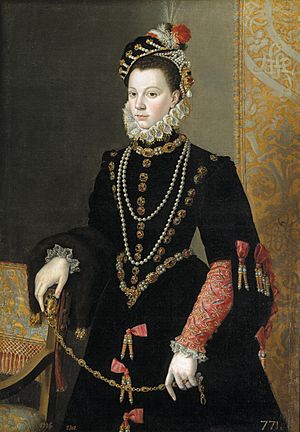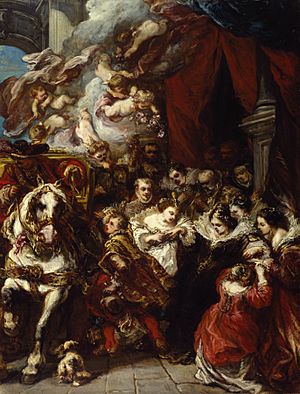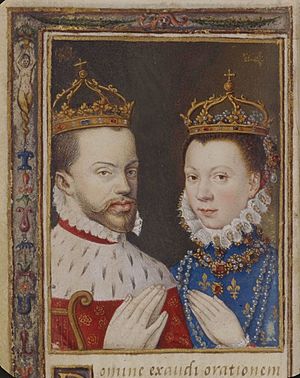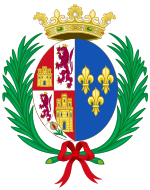Elisabeth of Valois facts for kids
Quick facts for kids Elisabeth of Valois |
|
|---|---|

Portrait by Juan Pantoja de la Cruz
|
|
| Queen consort of Spain | |
| Tenure | 22 June 1559 – 3 October 1568 |
| Born | 2 April 1545 Palace of Fontainebleau, France |
| Died | 3 October 1568 (aged 23) Royal Palace of Aranjuez, Spain |
| Burial | El Escorial |
| Spouse | |
| Issue | |
| House | Valois-Angoulême |
| Father | Henry II of France |
| Mother | Catherine de' Medici |
Elisabeth of France (also known as Elisabeth of Valois) was a French princess who became the Queen of Spain. She was the third wife of Philip II of Spain. Elisabeth was born on April 2, 1545, and passed away on October 3, 1568. She was the oldest daughter of Henry II of France and Catherine de' Medici.
Early Life
Elisabeth was born at the Château de Fontainebleau in France. She grew up in the royal nursery. Her father made sure she shared her room with her future sister-in-law, Mary, Queen of Scots. Mary was about three years older than Elisabeth. Even though Mary was already a crowned queen, the two girls became very close friends. They stayed friends throughout their lives.
Elisabeth was known for being shy. She looked up to her powerful mother, Catherine. Letters show that Catherine was loving towards her daughter. While her sister Margaret and Mary were considered prettier, Elisabeth was still seen as one of Catherine's attractive daughters.
When Elisabeth was five years old, her father, King Henry, started planning her marriage. He wanted her to marry Edward VI of England. This idea made Pope Julius III unhappy. However, the plans changed when Edward died in 1553.
Queen of Spain
Elisabeth married Philip II of Spain in 1559. First, a ceremony was held in France where someone stood in for Philip. This is called a proxy marriage. The real wedding happened in Guadalajara, Spain, after Elisabeth arrived. This marriage helped to create peace between France and Spain. Philip's second wife had recently died, making Elisabeth his third wife.
When Elisabeth arrived in Spain, her French ladies-in-waiting changed their clothes to the Spanish style. At her wedding, she met the artist Sofonisba Anguissola. Philip II made Anguissola a lady-in-waiting and a court painter for his queen. Elisabeth improved her own painting skills with Anguissola's help. Anguissola also influenced the art of Elisabeth's daughters.
Philip was very fond of his young bride. He even stopped his unfaithful ways by 1564. Elisabeth was also happy with her husband. She wrote to her mother that she was lucky to have married such a charming prince. Philip enjoyed holding chivalric tournaments to entertain his wife.
Elisabeth was first supposed to marry Philip's son, Carlos, Prince of Asturias. But political reasons changed the plan, and she married Philip instead. Her relationship with her stepson Carlos was friendly and warm. Carlos was always kind to Elisabeth. When Philip had to keep Carlos away, Elisabeth was very sad.
Philip stayed close to Elisabeth, even when she was sick with smallpox. Elisabeth had a difficult time with pregnancies. In 1560, she sadly lost a baby. In 1564, she lost twin girls early in her pregnancy. She later gave birth to two daughters who survived. Infanta Isabella Clara Eugenia of Spain was born in 1566. Her younger sister, Catherine Michelle of Spain, was born in 1567. Philip and Elisabeth loved their daughters very much. They bought them toys, dolls, and jams. People said they were as happy about Isabella's birth as if she had been a son.
Elisabeth had another pregnancy in 1568. Sadly, she died on October 3, 1568, along with her newborn baby daughter. After Elisabeth's death, her mother offered her younger daughter, Margaret, to Philip as a new wife. Philip did not accept the offer.
In Stories and Movies
Elisabeth of Valois appears in many plays and operas. These include Don Carlos, Prince of Spain by Thomas Otway and Don Carlos by Schiller. There is also an opera by Giuseppe Verdi called Don Carlos. These stories often show a sad romance between Elisabeth and Carlos. They suggest that Elisabeth and Carlos were in love before she had to marry his father, Philip.
In the book The Princesse de Cleves, Elisabeth's wedding to Philip II is important. It is during the wedding celebrations that her father, King Henry II, dies.
Elisabeth of Valois is also a character in the TV show Reign. In the show, her personality is changed. She is shown as more forceful and controlling, driven by her desire for her mother's love.
Elisabeth is a main character in the novel The Creation of Eve. This book is about Sofonisba Anguissola, a famous female artist. In the story, Sofonisba teaches young Queen Elisabeth how to paint.
Sources
- Anselme de Sainte-Marie, Père (1726) (in fr). Histoire généalogique et chronologique de la maison royale de France. 1 (3rd ed.). Paris: La compagnie des libraires. https://gallica.bnf.fr/ark:/12148/bpt6k76026j/f149.image.
Images for kids
|
Elisabeth of Valois
Cadet branch of the Capetian dynasty
Born: 2 April 1545 Died: 3 October 1568 |
||
| Spanish royalty | ||
|---|---|---|
| Vacant
Title last held by
Mary I of England |
Queen consort of Spain 1559–1568 |
Vacant
Title next held by
Anne of Austria |
See also
 In Spanish: Isabel de Valois (reina de España) para niños
In Spanish: Isabel de Valois (reina de España) para niños






